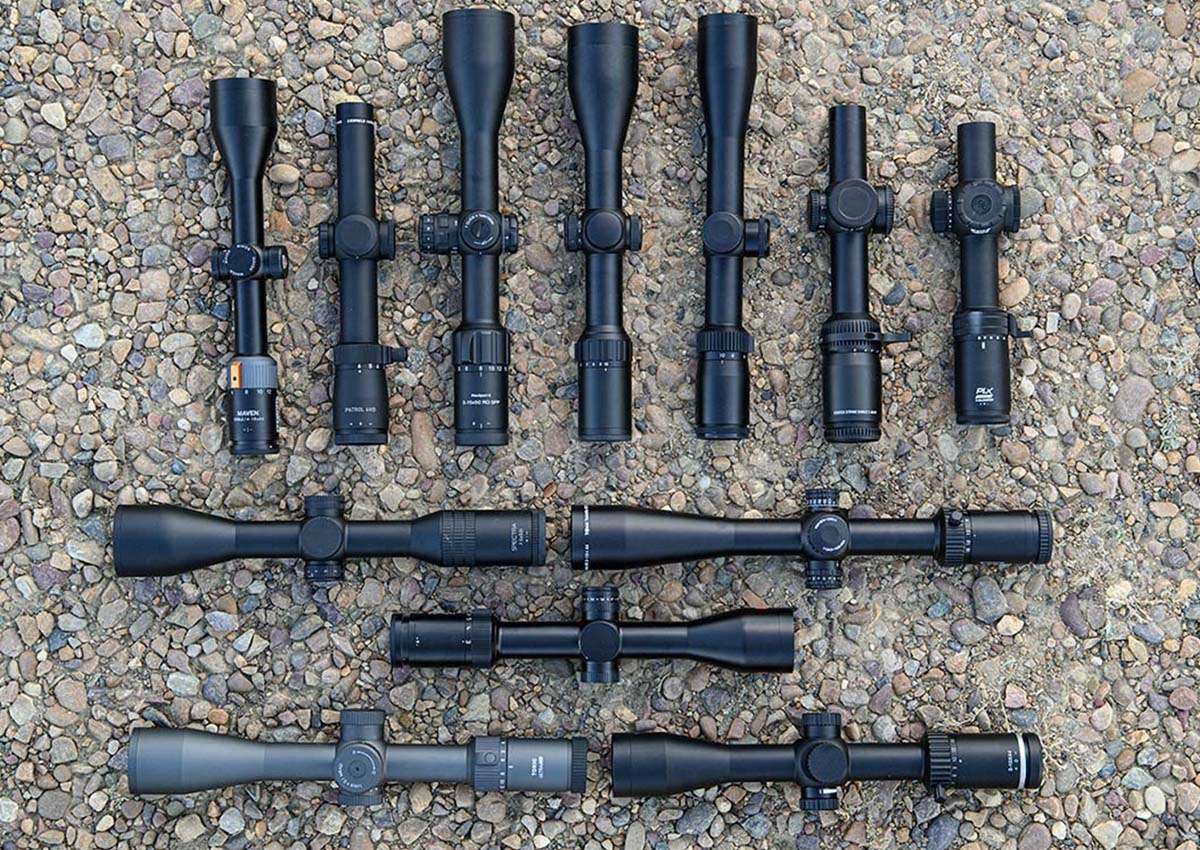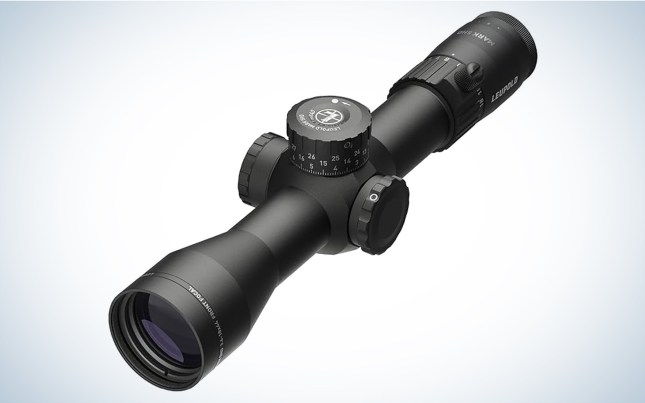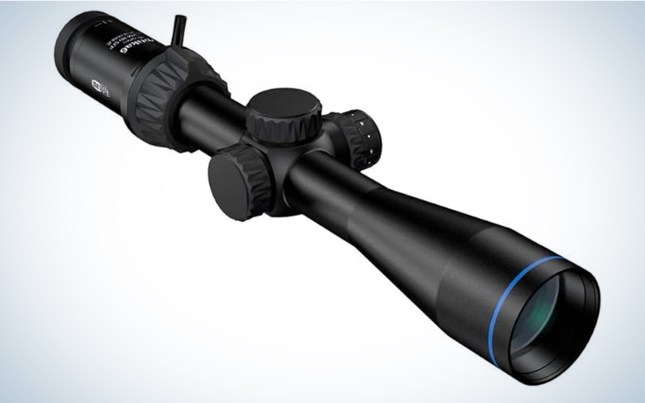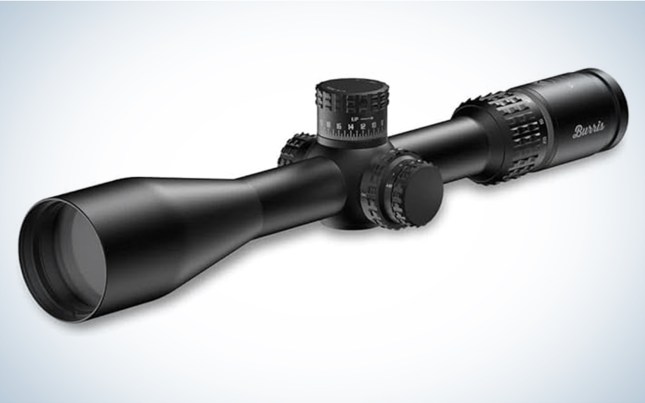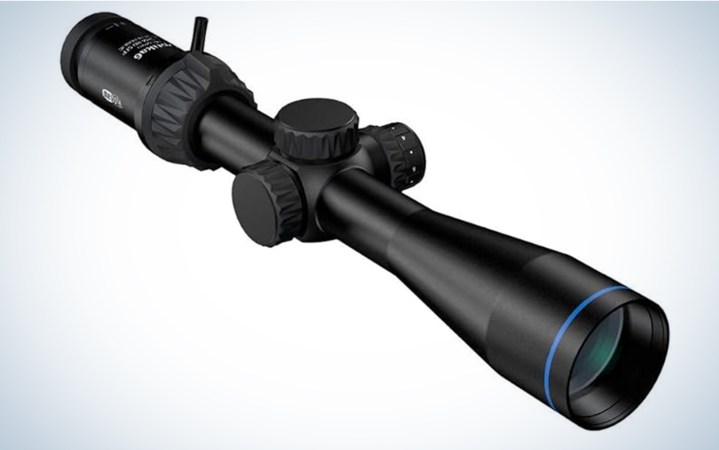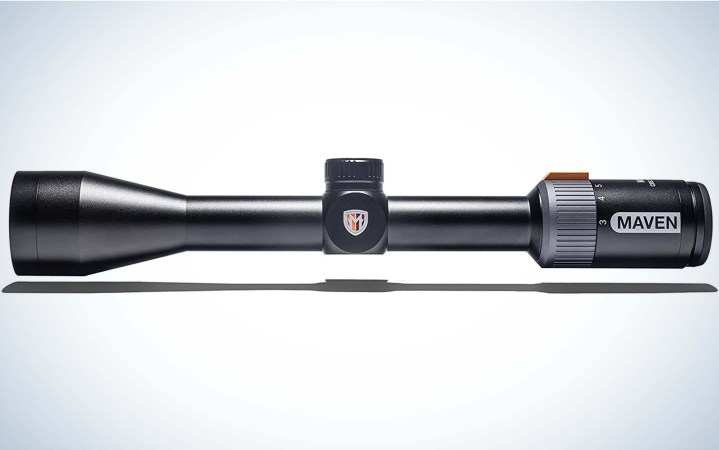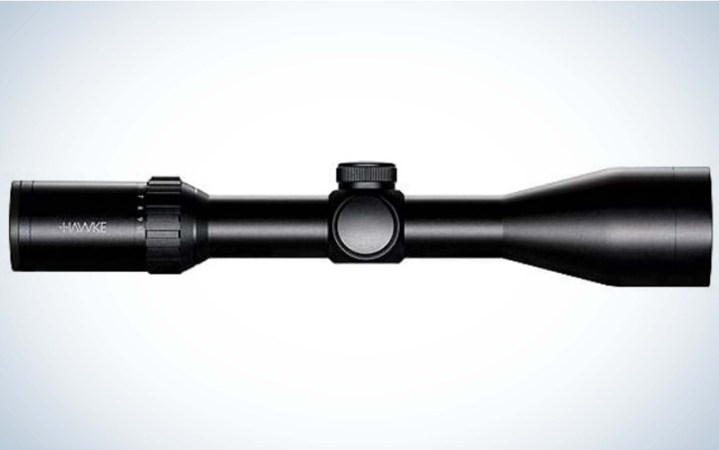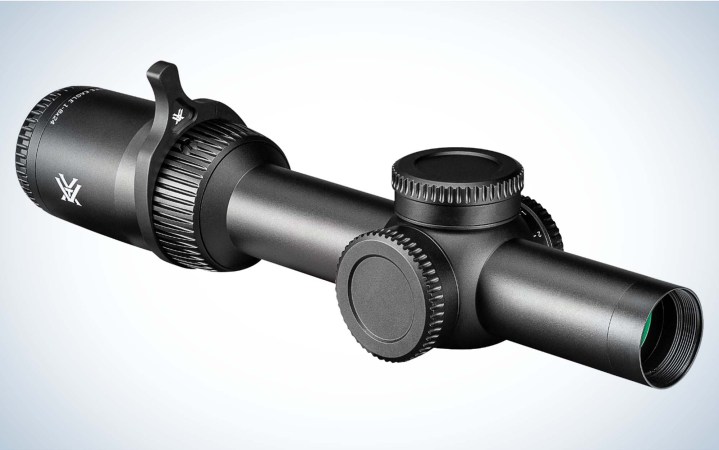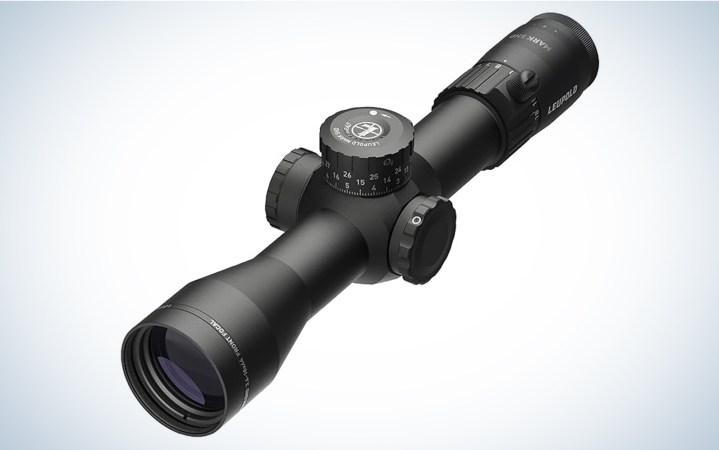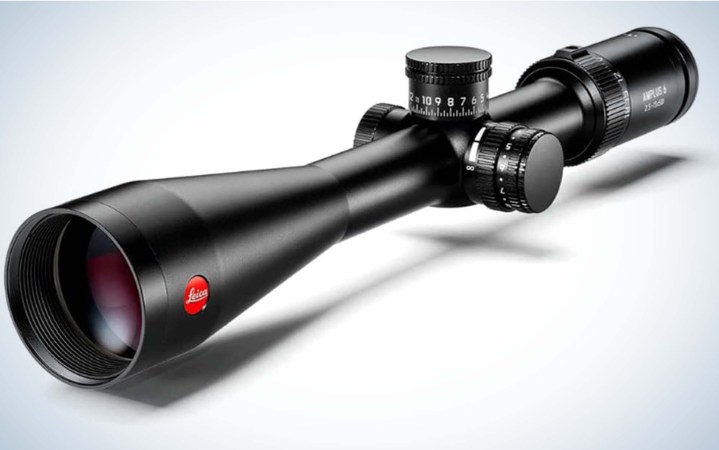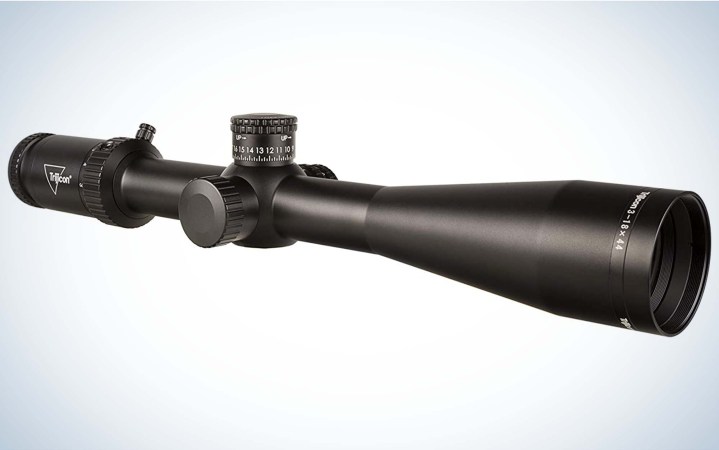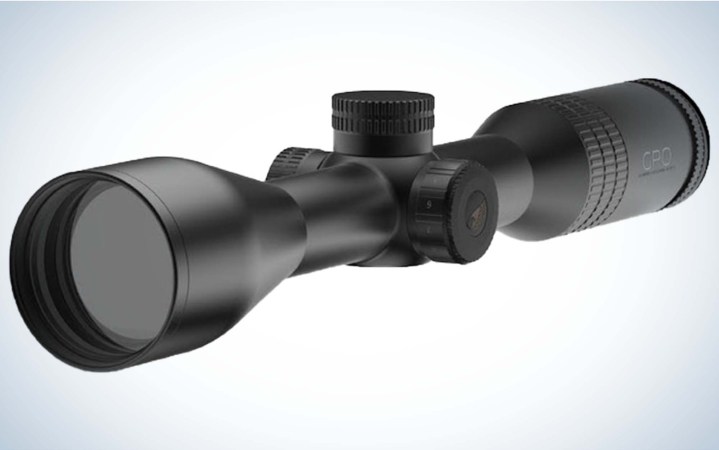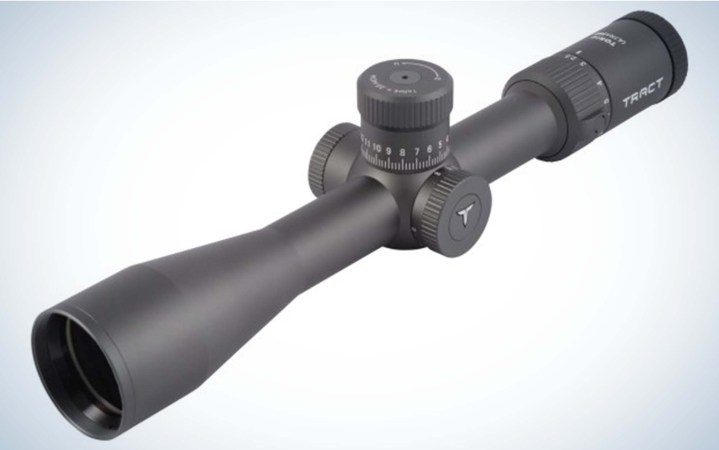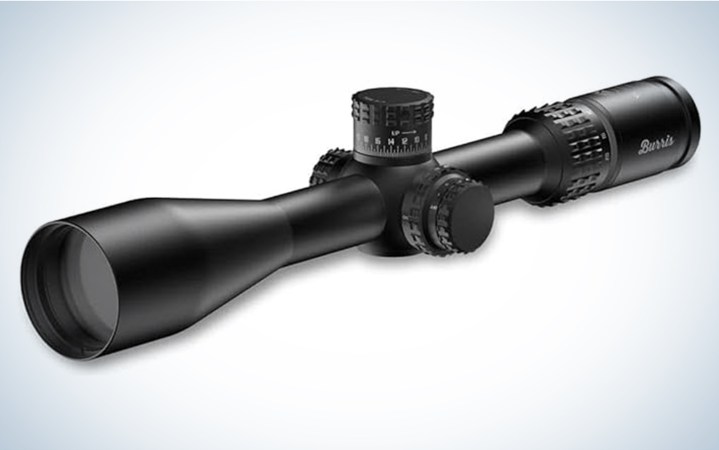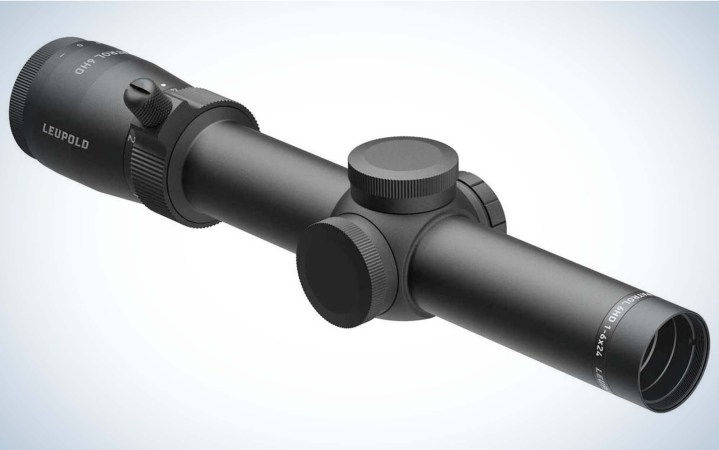We may earn revenue from the products available on this page and participate in affiliate programs. Learn More ›
We’ve turned ourselves inside out trying to find the single perfect rifle scope for all deer hunters. I’ll skip to the punchline: It doesn’t exist.
Scopes with the simple reticle and hard-wearing durability demanded by Midwest whitetail hunters don’t have the holdover references and easy-dialing turrets that Western mule deer hunters require for long shots. Northwest blacktail hunters want an illuminated aiming point, while deer hunters participating in new straight-wall cartridge hunts in those states that begin with a vowel are looking for low-power carbine scopes.
Given the divergent needs of America’s deer hunters, we’ve divided our group of suitable scopes into three classes, those configured for classic whitetail hunting situations, those low-power scopes for quick shots in close quarters, and those engineered to make long shots in variable conditions. Each scope in this roundup has features that elevate it above its peers. For some, that’s best-in-class glass, for others, it’s extremely useful reticles, and for others durability or affordability. Here are the best rifle scopes for deer hunting from the Outdoor Life 2022 and 2023 optics tests.
Best Whitetail Deer Rifle Scopes
- Best Value: Meopta Optika6 2.5-15×44
- Best Lightweight: Maven CRS.1 3-12×40
- Best Budget: Hawke Vantage 30 WA IR 2.5-10×50
- Best for Treestands: Vortex Strike Eagle 1-8×24
Best Western Deer Rifle Scopes
- Best All-Around: Leupold Mark 5HD
- Best High-End: Leica Amplus 6 3-18x44i
- Best First-Plane: Trijicon Tenmile HX 3-18×44
- Best for Low-Light: GPO Spectra 7.5x50i
- Best Mule Deer Scope: Tract Toric Ultra HD 2.5-15×44
- Most Innovative: Burris Veracity PH 4-20×50
- Best for Blacktail: Leupold Patrol 6HD 1-6×24
How I Chose the Best Deer Hunting Scopes
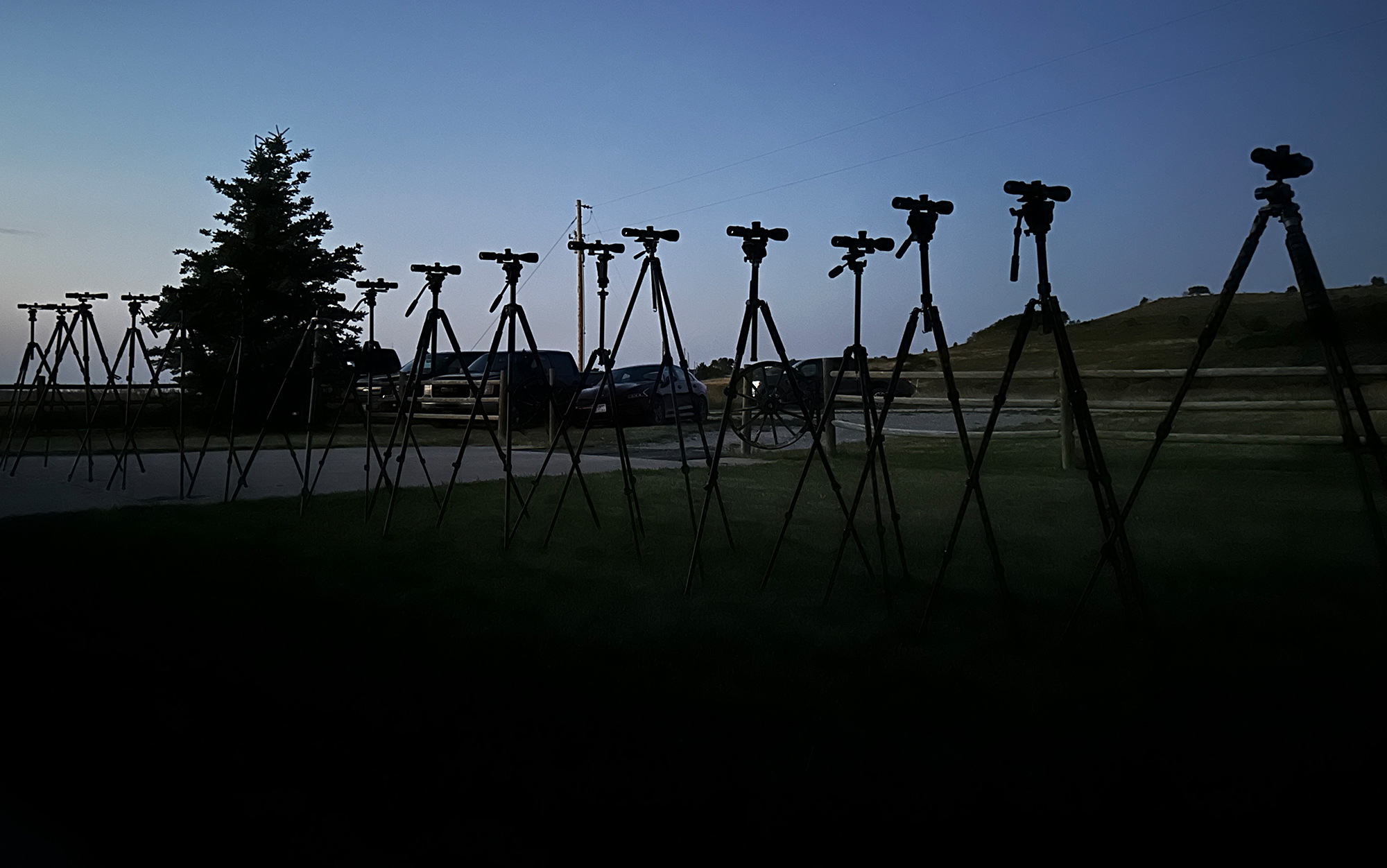
Some of the scopes in this roundup were new for 2022 and were included in the rigorous evaluations of Outdoor Life’s annual optics test a full year ago. Others were introduced in 2023 and participated in this year’s iteration of our best-in-class test. The list is proudly subjective; some of your favorite scopes simply don’t have the talent to make the grade, or they’re so narrowly useful that they don’t have the versatility required by deer hunters.
Scopes in our test undergo a number of objective evaluations and an equal number of subjective assessments.
Our riflescope testing regimen differs from the way we test binoculars and spotting scopes, optics whose job is mainly to help us observe. Riflescopes must also place bullets with absolute, repeatable precision, so our scoring criteria gives more weight to attributes that achieve that goal.
We test optical performance, same as we do with spotters and binoculars. But we spend more time on four criteria that we think are the heart of a solid riflescope. Our “interior aiming system” considerations are reticle style and utility, illumination, reticle references and visibility. Our “exterior aiming system” evaluation considers turret positivity and indexing, the scope’s zero stop, parallax control, and total internal adjustment range, or how far shooters can stretch the turrets’ elevation and windage clicks. We also test a range of attributes that we bundle under the heading “precision,” which include turret tracking, return to zero, the trueness of the scope’s magnification, parallax, and field of view. And then we ask testers to rate every scopes’ “shootability,” which considers eye relief, the ease of use at various magnifications, and the scope’s versatility.
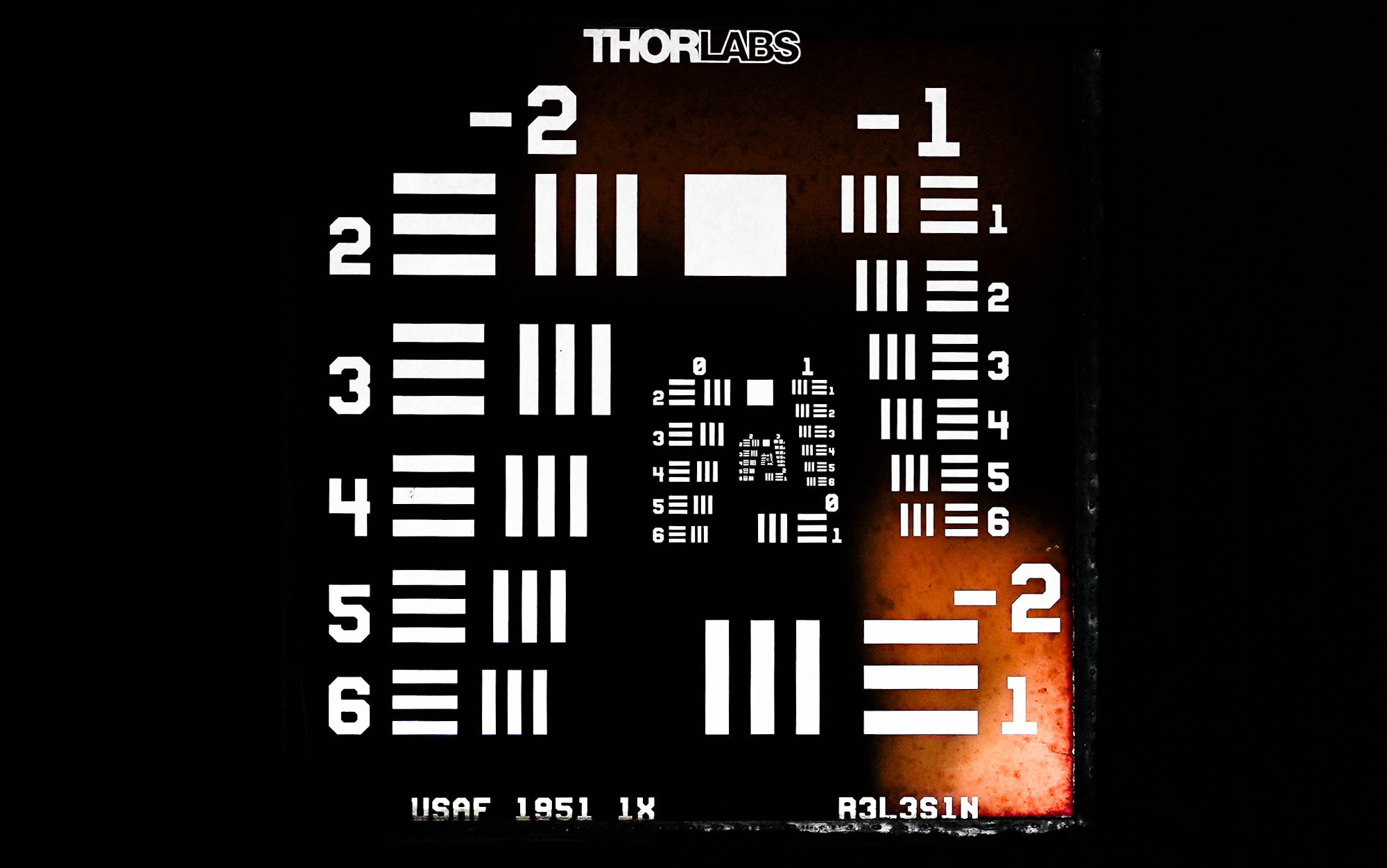
Our first task is to measure optical resolution, using the diminishing black-and-white lines of a 1951 Air Force Resolution Target to score the optical performance of each submission. We also measure the low-light performance of the best rifle scopes for deer hunting by mounting them to tripods and focusing them as a group at 200 yards at a black-and-white resolution target at twilight, all in order to measure the brightness of the glass.
How We Score Rifle Scopes for Deer Hunting
We break our scoring into four general categories: optical performance (25 percent of total grade), aiming system (50 percent of total grade), design (10 percent), and value (15 percent).
Optical performance includes the resolution and low-light tests plus the more subjective assessments of image quality and brightness. Aiming-system performance assesses interior and exterior aiming system, precision, and shootability. Design considers the exterior finish, interior blacking, mounting dimensions, and durability. And then our price/value score rates how much scope—along with warranty and amenities such as rings, extra turrets, and lens covers—you get for your money.
Because these are scopes selected for deer-hunting capabilities, I rated their ability to perform a series of shooting tasks, engaging targets at 20 yards, then at 100, and in 100-yard steps out to 600 yards. For each distance, I evaluated the reticle, image, and turret controls. I repeated the shooting exercise in full sunlight and low-light conditions. I lugged all these scopes into a ladder stand and evaluated their abilities to make quick snap shots at close ranges.
For each, I made a subjective determination of optical quality, looking for distortions, optical aberrations, and any distracting jags of light. And I determined how quickly and precisely I could use the reticle and how quickly and comfortably my eye found the center of each scope.
Lastly, I assessed the extras, including the accessories and each submission’s warranty.
Best Whitetail Deer Rifle Scopes: Reviews & Recommendations
I’m guilty of a gross generalization here, but the woodland and farm-country deer hunter wants a rifle scope that delivers good low-light performance and can assist with fast shooting. Big, exposed tactical turrets don’t belong here, and neither do complicated reticles. These scopes all have some combination of optical superiority and fast aiming.
Best Value: Meopta Optika6 2.5-15×44
Best Value
Meopta Optika 6 2.5-15×44
Key Features
- Weight: 27.2 ounces
- Magnification Range: 2.5-15X
- Objective Lens Diameter: 44mm
- Tube Diameter: 30mm
- Turret Click Values: .25 MOA
- Reticle Focal Plane: Second
- Illuminated Reticle: No
Pros
- Very appealing price
- 30mm tube provides wide adjustment range
- Duplex reticle delivers fast aiming
- Excellent optical coatings
- 10-yards-to-infinity parallax control
Cons
- Controls have oversized rubber grips
- Lack of illumination limits utility
A do-everything scope that features reliable controls behind a modest objective bell, the Optika6 can be mounted low on a rifle and give you years of trouble-free performance. The second-plane reticle—choose between a standard plex and a plex-BDC (or bullet-drop compensating) holdover reticle—is clean and aids quick shots. And the 6-times zoom range covers the waterfront from close-in whitetails to mid-distance mule deer and elk.
With the Optika6 line, Meopta has again hit the sweet intersection of price and performance. While there’s nothing particularly wow-worth of this workaday scope, it fits a wide range of platforms and hunting situations. And for about $600, it’s right in line with other mid-range scopes but has the benefit of best-in-class glass and coatings.
The Optika6 is offered in both a simple plex reticle and a Plex-BDC, both in the second plane. Opt for the BDC, as it gives you a few holdover references inside the standard plex architecture. The parallax, which focuses as close as 10 yards, makes this a great small-game rimfire scope, but its 70MOA elevation range allows for modest dialing. It’s not going to win any long-range games, but it’s not intended to be anything more than a solid, reliable scope for a wide range of hunting situations.
Best Lightweight: Maven CRS.1 3-12×40
Best Lightweight
Maven CRS.1 3-12×40
Key Features
- Weight: 14.2 ounces
- Magnification Range: 3-12X
- Objective Lens Diameter: 40mm
- Tube Diameter: 1-inch
- Turret Click Values: .25 MOA
- Reticle Focal Plane: Second
- Illuminated Reticle: No
Pros
- Light and compact
- Parallax fixed at 100 yards
Cons
- Fixed parallax limits long-range work
- Bold styling too blingy for some hunters
While this charming little scope has plenty of attributes for a mountain hunter—light weight, bright glass, with just enough reticle references for mid-range work—it’s actually a wonderful whitetail scope. I’d stick with the CRS.1 for the widest utility, but if you want a little more magnification plus parallax focus, then go with the 4-16×44 CRS.2, which costs an extra $100.
A stylish, no-frills scope from a direct-to-consumer brand, the CRS.1 is the bare-boned version of a new Maven platform. If you want side focus and a little more magnification, consider the 4-16×44 CRS.2, but most whitetail hunters want a simple, durable, versatile scope, and the CRS.1 is just the ticket. The CRS.1 offers a ton of mounting dimension on its 1-inch tube, responsive turrets tuned to ¼ MOA click values under protective caps, and a velvety power-changing dial, and just enough bling to add some pizazz to your rifle. It’s also one of the best rifle scopes under $500.
To my eye, this is a perfect companion to a flat-shooting ultralight mountain rifle for a hunter who intends to get within range to hold right on the target with the center of the classic German 4 reticle. But in case you need some holdover references for mid-distance shots, the CRS.1 provides three hashes that should get you on target out to 500 or 600 yards. In other words, you can still make that long shot across the bean field at that whitetail of a lifetime.
Best Budget: Hawke Vantage 30 WA IR 2.5-10×50
Best Budget
Hawke Vantage 30 WA IR 2.5-10×50
Key Features
- Weight: 21.1 ounces
- Magnification Range: 2.5-10X
- Objective Lens Diameter: 50mm
- Tube Diameter: 30mm
- Turret Click Values: .25 MOA
- Reticle Focal Plane: Duplex in the second plane
- Illuminated Reticle: Yes, red and green center dot
Pros
- Simple aiming system
- Durable capped turrets
- Red and green center-dot illumination
- 60 MOA internal adjustment
- Extremely affordable
Cons
- No side focus
- Indistinct turret clicks
- Meh glass
Bright, affordable, and extremely versatile, this scope won’t win long-distance shooting medals, but it will place bullets in deer country with confidence. The Outdoor Life optics test team still doesn’t know how Hawke packs so much performance in such an affordable package. This is one of the best all-around scopes in the 2022 test. If it’s not built for long-distance (or even mid-distance) precision, it’s fast, bright, and nimble in many close-in and moderate distances. The best feature of the Vantage is the bold reticle with a precise, illuminated (red and green) center aiming point. We also like the low-light performance of the big 50mm objective lens.
The basic Vantage 30 WA is a good value, but if you want more mid- and longish-distance performance, consider the tactical version of this scope, with exposed high-profile turrets and a holdover reticle tuned to the ballistics of standard .223 and .308 loads. That version is maybe the ultimate deer scope.
Best for Treestands: Vortex Strike Eagle 1-8×24
Best for Treestands
Vortex Strike Eagle 1-8×24
Key Features
- Weight: 23.9 ounces
- Magnification Range: 1-8X
- Objective Lens Diameter: 24mm
- Tube Diameter: 30mm
- Turret Click Values: .25 MOA
- Reticle Focal Plane: Open-horseshoe in first focal plane
- Illuminated Reticle: Yes
Pros
- Wonderfully versatile illumination
- Reticle offers useful holdovers at higher magnifications
- Short stature fits carbine rifles
- Tons of internal adjustment for turret dialers
- Battle-hardened hardware
- VIP warranty
Cons
- Limited to short- to mid-distance shooting
- Not great low-light performance
Along with the Leupold Patrol 6HD, this is the leading edge of a new type of close-quarters deer scope that is a perfect match with an AR, slug gun, or straight-wall cartridge rifle. The Vortex Strike Eagle 1-8×24 is a low-power variable optic with plenty of chops for close to mid-range hunting. It has best-in-class rapid target acquisition inside 50 yards, but its first-plane reticle enlarges to reveal some sweet and useful aiming points that make it useful for 400-yard precision.
This is really an AR scope that can engage targets inside houses and then place precise shots across a field. Those attributes make it great for Midwest whitetail hunters (or Canadian bear hunters) who expect to see game right under their stand but need to be prepared to take shots out across a clearing. Paired with any number of firearms platforms, this has very positive and precise controls, from turret clicks to the power-changing dial.
Best Western Deer Rifle Scopes: Reviews & Recommendations
Open-country deer hunters have specific requirements in a rifle scope. They want it to be light enough to carry for miles over rugged country. They want it to be fast, in case the buck of a lifetime busts out of a coulee before they can range distance and dial the turrets. And they want plenty of reticle references to place precise shots over longish distances in slow-fire situations. These five scopes have attributes that will put the muley or Coues deer of a lifetime on the wall. And they’re pretty good for antelope and Western predator hunting, too.
Best All-Around: Leupold Mark 5HD 3.6-18×44
Best All-Around
Leupold Mark 5HD 3.6-18×44
Key Features
- Weight: 26 ounces
- Magnification: 3.6-18X
- Objective Lens Diameter: 44mm
- Tube Diameter: 35mm
- Reticle Type: Either MIL or MOA hash-style in first plane
- Turrets: .25 MOA/.1 MIL click values
- Illumination: No
- Parallax: Yes
Pros
- Low-profile mounting dimensions
- Precise first-plane reticle
- Exposed lockable and re-zeroable elevation turret
- Capped windage turret
- 15 yards to infinity parallax focus
- Excellent glass and coatings
Cons
- Busy reticle for holdover shooters
- 35mm tube is hard to match with rings
- At about $2,000, it’s pricey
A true crossover hunting/target scope, the Mark 5HD has a reasonable magnification range for mid- and long-distance hunting and a first-plane reticle that is available in MOA, MIL, or TMR styles. With a locking elevation turret, capped windage turret, and plenty of adjustment range, this scope is equally at home on long-range steel courses of fire.
Weighing 26 ounces, this burly scope feels lighter, probably because shooters are used to the ponderous heft of big precision scopes. The 44mm objective and low-profile turrets give this bantam all the benefits of a mid-sized scope with the guts of a full-size precision scope. The first-plane reticle provides a tremendous amount of holdover and holdoff reference. For shooters who want to dial, the 35mm tube allows for 100 MOA of internal adjustment (that’s 29 MILs). The locking dial is fast and secure, and a fast-action competition dial is also available, as is Leupold’s Custom Dial System, so you can have an elevation knob cut to the ballistic curve of your particular load.
The Leupold’s glass is excellent, its controls are positive and repeatable, and its eyebox is generous and bright. Yes, you should expect all that for $2,000, but the scope is a relative bargain when you consider its unique ability to handle long-range steel shooting as well as most hunting scenarios. Why buy two scopes when this one can do nearly everything you ask of it?
Best High-End: Leica Amplus 6 3-18x44i
Best High-End
Leica Amplus 6 3-18x44i
Key Features
- Weight: 23.6 ounces
- Magnification: 3-18X
- Objective Lens Diameter: 44mm
- Tube Diameter: 30mm
- Reticle Type: MOA hash in second plane
- Turrets: .25 MOA click values
- Illumination: Yes, 10 intensity levels
- Parallax: Yes
Pros
- Available in MOA or MRAD versions
- European style
- Excellent glass and coatings
- Precise parallax focus
- Abundant elevation and windage references
- Capped windage turret
- Center-point illumination
Cons
- Matte finish shows mars
- Busy reticle obscures view
Built around Leica’s legendary bright and crisp glass, the Amplus 6’s reticle and controls make this an essential deer hunting scope. The hash reticle offers 20 MOA of elevation and windage references, and the exposed turret makes dialing for distant hits fast and simple.
An elegant, extremely useful rifle scope, Leica’s Amplus line combines European glass and styling with precise reticle and turret combinations. Our sample was tuned to MOA references, but Leica also has a mil-based version of the Amplus. The scope is also available in higher magnification ranges (all are in the 6X zoom range, hence the 6 in the Amplus name) and larger objective lenses, but our relatively lightweight 3-18×44 is just about perfect for a Western deer rifle. The ability to re-zero the elevation turret without tools is a great feature, and the turrets turn with positivity and precision.
The reticle gets mixed reviews. Long-distance precision shooters will love the 20 MOA of elevation and windage hashes, but hunters used to clean, clutter-free reticles will complain that it’s overly busy and image-obscuring. Either way, the illuminated center aiming point can be muted or daylight-bright, depending on light conditions. It’s not cheap, but this is an heirloom-quality deer hunting optic.
Best First-Plane: Trijicon Tenmile HX 3-18×44
Best First-Plane
Trijicon Tenmile HX 3-18×44
Key Features
- Weight: 24.4 ounces
- Magnification: 3-18X
- Objective Lens Diameter: 44mm
- Tube Diameter: 30mm
- Reticle Type: MOA hash/dot in first plane
- Turrets: .25 MOA click values
- Illumination: Yes, red and green
- Parallax: Yes
Pros
- Liberal mounting dimensions
- Precise first-plane reticle
- Exposed re-zeroable elevation turret
- Capped windage turret
- 15 yards to infinity parallax focus
- Low-profile mounting
- Ships with integral lens caps
Cons
- Busy reticle for holdover shooters
- Exposed turrets can inadvertently turn
- Pricey
A true crossover hunting/target scope, the Tenmile HX and its first-plane reticle will dominate just about any mid- to long-distance shooting situation. We debated whether to put this very capable 30mm scope in our precision or our versatile scope categories. That’s how much of a fence-rider this optic is, between a full-on steel-ringer for long-distance target shooters and walk-about Western hunters. Our best description of its place in the market is that this is the perfect hunting optic for a shooter who is familiar with first-plane reticles and turret dynamics of the long-distance target crowd but who wants a slim and capable hunting scope.
That describes an increasing number of Western deer hunters. They want all the precision aiming components of their big 5-25×56 target scopes with the portability of slim and nimble hunting scopes. The Trijicon satisfies both populations with a bright and precise scope that can cross over from long-range steel to open-country mule and Coues deer.
Best for Low-Light: GPO Spectra 7.5x50i
Best for Low-Light
GPO Spectra 7.5x50i
Key Features
- Weight: 21.7 ounces
- Magnification: 7.5X
- Objective Lens Diameter: 50mm
- Tube Diameter: 30mm
- Reticle Type: German 4 duplex in second plane
- Turrets: .1 milliradian
- Illumination: Yes, red center-point
- Parallax: No
Pros
- Extremely simple aiming dynamics
- Infinitely adjustable illumination
- Durable
- Fast aiming platform
- Turrets move with repeatable precision
- Fixed power increases brightness
Cons
- Fixed power limits utility
- Limited reticle references
An extremely capable modern variation on a classic fixed-power hunting scope, the GPO Spectra cuts out all the nonsense of reticle references and turret dialing. This is a bright, durable fixed-power 7.5, a perfect pairing with a flat-shooting bolt rifle when you want to concentrate on hunting, not fiddling with your scope.
The glass is very good, the center-point illumination extremely variable, and the turrets turn with repeatable precision. For hunters who want to concentrate on making short- to mid-distance shots every time, this is a good choice. Extreme long-range hunters and shooters may want more focal control, a more sophisticated reticle, and tactical turrets. But for the rest of us, this is a very capable close- to mid-range scope that performs best in low-light hunting scenarios. It’s nice to see this style of scope back in the American marketplace.
Best Mule Deer Scope: Tract Toric Ultra HD 2.5-15×44
Best Mule Deer Scope
Tract Toric Ultra HD 2.5-15×44
Key Features
- Weight: 28.3 ounces
- Magnification: 2.5-15X
- Objective Lens Diameter: 44mm
- Tube Diameter: 30mm
- Reticle Type: Hash-style in first focal plane
- Turrets: .1 milliradian
- Illumination: No
- Parallax: Yes, 10 yards to infinity
Pros
- Wonderfully responsive turret clicks
- First-plane reticle rare in this configuration
- Bright, distortion-free Schott glass
- Capped windage turret
- Versatile first-plane reticle
- Wide parallax range
- Handsome graphite finish
Cons
- Reticle utility begins at about 5X
- Needs clear center aiming point
- Illumination would help with close-in aiming
The most capable cross-over target-to-hunting rifle scope in this year’s Outdoor Life optics test is a bright, tight, and precise first-plane scope that can reach out for both distant steel targets and open-country deer. The top cross-over scope of 2023, this bright and tactile first-plane hunting scope can put Western deer hunters on target out to 500 yards and beyond, depending on how familiar they are with reticle references. The robust pull-to-turn elevation turret and capped windage turret are both tuned to .1 MRAD click values, and the hash-style reticle offers 10 mils of drop and 8 mils of windage hold on either side of the non-distinct center aiming point.
This Tract Toric is a relatively light scope with abundant mounting options, making it a good pairing for a long-range hunting rig or even for many flat-shooting ultralight hunting rifles. Surprisingly, it’s also an excellent precision rimfire optic, with close-focus to 10 yards and a capable first-plane hash-style reticle that can put shooters on target at a wide range of magnifications and distances.
Most Innovative: Burris Veracity PH 4-20×50
Most Innovative
Burris Veracity PH 4-20×50
Key Features
- Weight: 27.2 ounces
- Magnification: 4-20X
- Objective Lens Diameter: 50mm
- Tube Diameter: 30mm
- Reticle Type: MOA hash in first plane
- Turrets: .25 MOA click values
- Illumination: Yes, 10 intensity levels
- Parallax: Yes
Pros
- PEK turret shows distance in digital display
- Clickless elevation turret
- 50-yards-to-infinity side focus
- Simple and solid zero stop
- Mates well with BurrisConnect ballistic app
- Turrets work manually in case of power failure
- Scope has built-in cant sensor
Cons
- Steep learning curve
- Underwhelming glass
A very interesting mash-up of optics and digital technology, this groundbreaking new scope from Burris allows shooters to range their target, then turn the elevation turret to the precise distance, and then use a variety of inputs to make a shot. The heart of the unit, which is built around Burris’s excellent Veracity scope, is the PEK turret. That stands for Programmable Elevation Knob; it essentially controls a digital heads-up display in the scope’s field of view that shows holdover at known distances. Say you range a target at 823 yards. Simply turn the turret until 823 shows up in the display, and then use the BurrisConnect app or other inputs to hold for a distance-appropriate shot.
Once you get the hang of the system and match it to your particular load, it’s fast, precise, and enables shooters to extend their range.
You might consider this new and very innovative scope the bastard child of Burris’s excellent Veracity scope and its game-changing Eliminator. The former is a non-electrified scope with excellent glass and controls and a very useful second-plane reticle. The Eliminator has an on-board rangefinder and an electronic brain that calculates holdover, which it displays with a distance-adjusted dot. Hold the dot on your target and pull the trigger.
The Eliminator eliminates the guesswork of long shots to such a degree that animals killed with it aren’t eligible for trophy consideration in some rankings. The Veracity PH offers a fair amount of electronic aid without going as far as the Eliminator. Let’s talk about what the Veracity PH doesn’t have—a rangefinder. It also doesn’t have an internal hold-over reference. What it does have is a digital heads-up display inside the field of view that’s linked to the elevation turret. Range your target, dial the elevation turret to the distance displayed in the heads-up unit, and then use either holdover references or a ballistic app to determine your hold.
Burris makes it easy to use its proprietary BurrisConnect mobile app in conjunction with the PEK (Programmable Elevation Knob) system to derive very precise aiming solutions.
The scope has a number of other innovative features, including a clickless elevation turret that provides precise values, Bluetooth connection to the mobile app that provides display values in yards, meters, or MOA as well as rifle cant and target angle.
The scope takes a good deal of guesswork out of long shots while still requiring inputs and intelligence from the shooter, and the traditional reticle and turrets will still work even if the battery fails. Retailing for about $1,200, this is a bargain considering all the ballistic talent it contains.
Best for Blacktail: Leupold Patrol 6HD 1-6×24
Best for Blacktail
Leupold Patrol 6HD 1-6×24
Key Features
- Weight: 16.2 ounces
- Magnification: 1-6X
- Objective Lens Diameter: 28mm
- Tube Diameter: 30mm
- Reticle Type: Duplex in second plane
- Turrets: .25 MOA
- Illumination: Yes, 8-step intensity
- Parallax: No
Pros
- Extremely light weight
- Fast and open duplex reticle
- Durable
- Smart illumination system
- Excellent glass and coatings
Cons
- Not a precision scope
- Limited distance utility
This scope isn’t really intended for deer hunting. It’s designed for a wide range of firearms: AR platforms, or maybe dangerous-game rifles in Africa’s thickest thornbush, or even straight-wall lever guns. But its combination of low magnification, bright glass, and a laser-sharp illuminated aiming point make it an ideal treestand or whitetail brush scope.
Let’s start with what the Leupold Patrol 6HD is not. It’s not a precision scope. It won’t help you win long-range steel-target competitions or even precision rimfire matches. But it’s one of the best of a new generation of low-power variable optics that can absolutely put venison in your freezer. Paired with a straight-wall lever gun or an AR, a slug gun, or just about any centerfire rifle, this is a workhorse of an optic that enables fast shots, quick follow-ups, and decent performance at the first and last light of the day.
The low-profile push-button center-point (that’s a lot of hyphenated terms) illumination is one of the Leupold’s best features. It’s dimmable for low-light conditions and can intensify to bright visibility in full sunshine. If you want to increase the utility of this platform, consider a custom elevation dial tuned to the ballistics of your favorite load. Otherwise, go with the out-of-box talent of this durable, athletic, and versatile scope.
Things to Consider Before Buying a Rifle Scope for Deer Hunting
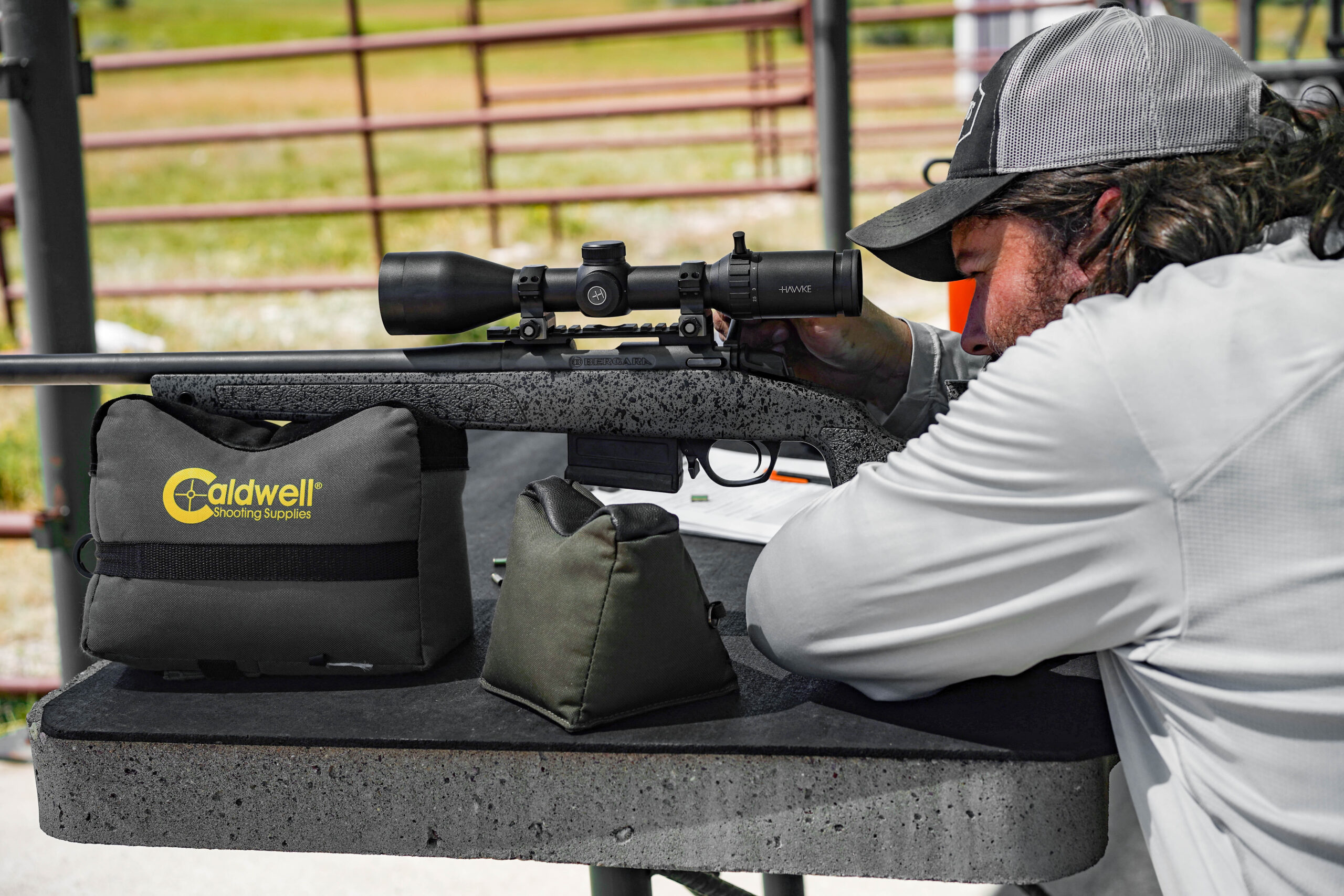
Deer hunters don’t really need a ton of features in their rifle scopes. A clear and clean reticle that lets them place bullets quickly and with mid-range precision: Check. A bombproof build that will endure the hardships of the field: Check. And versatility that will help hunters succeed in the deep woods or the open fields where you’ll find deer anywhere and everywhere: Check. Additional features are nice, but they get in the way of the simple reliability that most deer hunters require.
If deer are similar in their habits across their range, hunting styles differ by geography and species. The needs of an Eastern whitetail hunter (or Cascades blacktail hunter) are vastly different from those of an open-country Western mule deer or Coues deer hunter. For the former, fast reticles and the ability to make quick, reactive shots inside 100 yards are key. For the latter, lightweight builds that offer plenty of reticle references will enable shots that can stretch out to 400 and 500 yards to put bucks on the pole.
FAQs
The best magnification scope for deer hunting depends on the deer you’re hunting. For close-range whitetails, a 2-10-power scope has plenty of magnification. For an open-country mule deer, a 3-18-power is a better option. Along with magnification, consider the reticle type. A second-plane reticle will stay the same size regardless of magnification, but most bullet-drop references assume shooters are on the highest power. A first-plane reticle will appear larger with magnification, but the references remain constant regardless of power.
The larger the objective lens, the brighter the image will appear. So for deer hunters who expect to be making shots in the very first light of morning or the last light of evening, that larger objective lens will buy them some time, and boost their confidence in low-light situations. For walk-about hunters who are looking for lighter, lower-profile scopes, the 40mm class is a better option, at least until they need to make a long shot in failing light.
That’s a tough question—who makes the highest-quality hunting scopes. There’s a lot to consider. If you evaluate the optical performance, then the tip goes to the European brands with excellent glass and optical coatings, including Leica, Zeiss, and Swarovski. But if you’re talking reticles and turrets, then you should consider brands such as Nightforce, Sig, Leupold, and Trijicon.
The short answer is a resounding yes; a 10-power scope is enough for hunting. The more useful answer is that it depends on your hunting area. In dense hardwoods or evergreen groves, where shots are likely to be inside 100 yards, a low-power scope (2- to 6-power) is adequate. In the open country where you might hunt mule deer, you want more magnification, so a 3- to 18-power scope is a better option. You might consider 10-power as the tipping point between close and distant deer scenarios. For Eastern woodlands whitetail hunters, it should be considered maximum power. For Western mule deer hunters, it should be considered mid-range magnification.
Final Thoughts
Just as no two deer hunts are the same, no two deer hunters will have the same needs for their rifle scopes. But the requirements for an Eastern or Midwestern deer hunter are so wildly different than those of their Western brethren that we divided this class in half, with scopes for Western hunters showing their long-distance precision capabilities, and those for woodland hunters having simpler reticles and fast, intuitive builds.
You may want a scope that splits the difference and offers a reticle that zooms from close-in visibility to mid-distance precision. We have a few low-power variable scopes in this mix that you should consider. And for those who want a scope that can reach way out to a distant buck and serve as a long-range target scope, consider the first-plane, tactical-turret models in this group. Regardless of your tactics or where you hunt deer, you’ll have no problem finding one of the best rifle scopes for deer hunting in these capable contenders.
Best Whitetail Deer Rifle Scopes
- Best Value: Meopta Optika6 2.5-15×44
- Best Lightweight: Maven CRS.1 3-12×40
- Best Budget: Hawke Vantage 30 WA IR 2.5-10×50
- Best for Treestands: Vortex Strike Eagle 1-8×24
Best Western Deer Rifle Scopes
- Best All-Around: Leupold Mark 5HD
- Best High-End: Leica Amplus 6 3-18x44i
- Best First-Plane: Trijicon Tenmile HX 3-18×44
- Best for Low-Light: GPO Spectra 7.5x50i
- Best Mule Deer Scope: Tract Toric Ultra HD 2.5-15×44
- Most Innovative: Burris Veracity PH 4-20×50
- Best for Blacktail: Leupold Patrol 6HD 1-6×24
